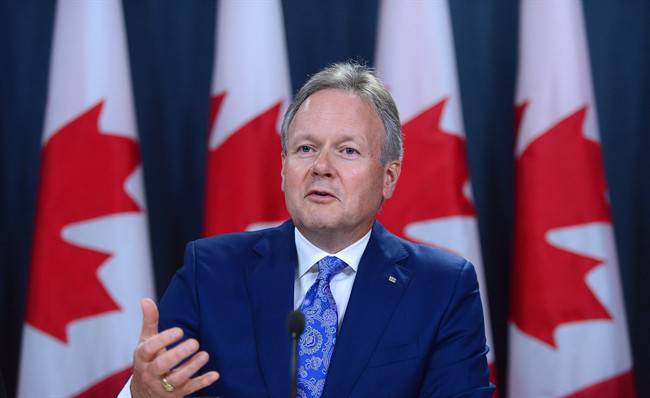
OTTAWA – Bank of Canada governor Stephen Poloz will give his updated outlook for the economy Wednesday in an appearance that many expect will send stronger signals the interest rate will be on hold for months.
Poloz will release new projections in a quarterly report that follows the economy’s sudden downshift in the final months of 2018. He’s predicted the slowdown, which was mostly caused by a drop in oil prices, to be temporary and for the economy to build new momentum later this year.
After hiking its key interest rate five times since mid-2017, the central bank has kept it at 1.75 per cent since last October.
Poloz is widely expected to stand pat once again Wednesday when he announces the bank’s latest policy decision.
“We are in clearly a watch-and-see environment,” said Frances Donald, head of macroeconomic strategy with Manulife Asset Management.
“Right now, the future is foggy. The best bet is probably to stay on the sidelines, continue to emphasize that there are both upside and downside risks to this economy and remind households, businesses and markets that on hold is a comfortable place to be for the foreseeable future.”
Donald, however, said Poloz will likely still keep the door open a crack to future rate hikes since the Bank of Canada has been intent on bringing the benchmark back up to normal levels.
Canada faces a number of internal and external economic hurdles. Expectations of a rebound in business investment and trade have so far failed to materialize, while there are predictions a primary economic driver – the Canadian consumer – could cut back on spending after accumulating piles of debt.
Last week, a Bank of Canada survey suggested business confidence fell earlier this year from elevated levels. Companies, the poll found, underlined uncertainty around the housing sector, the energy slump and global trade.
For its March policy announcement, the central bank’s statement said there was “increased uncertainty about the timing of future rate increases.” It was perceived as a watered-down message because, unlike its January statement, the bank no longer stressed a need for the benchmark to rise over time to a neutral range of between 2.5 and 3.5 per cent.
Alicia Macdonald, principal economist for The Conference Board of Canada, said she expects a “dovish” statement Wednesday from Poloz that will signal a prolonged pause in the bank’s rate-hiking cycle.
“I think the bank is really going to wait a good few months unless there is some really significant movement in the data, either up or down,” said Macdonald, who doesn’t expect a strong rebound in the second half of 2019 because of the weak business sentiment.
“I would think that now their concern would be more about taking a wait-and-see approach to see if the soft patch really does prove to be temporary.”
Benjamin Reitzes, BMO’s Canadian rates and macro strategist, predicted in a research note late last week that Poloz will remove the reference to future rate increases.
“It’s clear that any potential rate hike is a long way off, making any hiking bias unnecessary for now,” Reitzes said.
Other experts are more optimistic about the coming months.
Canada’s late-2018 weak stretch wasn’t quite as severe as many experts had predicted, said Brett House, deputy chief economist for Scotiabank Economics.
House expects the Bank of Canada to raise its economic growth projections for the first quarter of 2019, which it had pegged in January at just 0.8 per cent.
“We think the soft patch has been less soft than some have characterized it as being,” he said.
House said there’s also been enough underlying strength in the economy to encourage Poloz to maintain – and not further relax – his language about future rate hikes. On top of that, House noted how the core inflation rate was on target last month – which he considers clear evidence of price pressure.
Scotiabank is predicting another rate increase in 2019 and possibly another one in mid-2020.
But to get there House said factors likely holding back business investment and trade will need to ease. They include the yet-to-be-ratified North American trade pact, the U.S.-China trade spat, U.S. steel and aluminum tariffs and the threat of more U.S. levies on automobiles, he said.
“There’s just no room on the household front to provide an extra boost. It really has to come from the investment and trade side.”